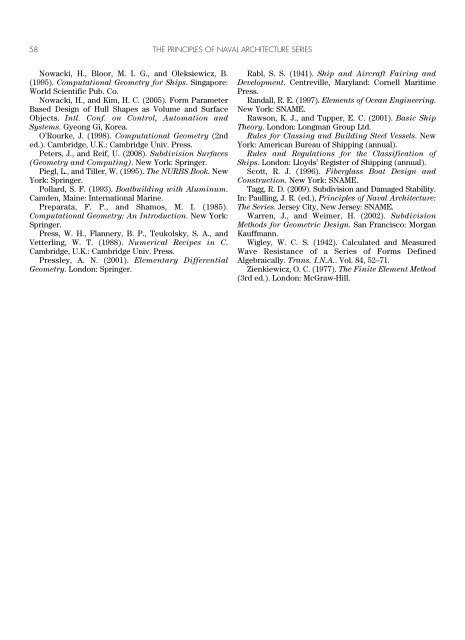The Geometry of Ships
Create successful ePaper yourself
Turn your PDF publications into a flip-book with our unique Google optimized e-Paper software.
THE GEOMETRY OF SHIPS 57<br />
surface about a longitudinal axis (for heel) or transverse<br />
axis (for trim), through the centroid <strong>of</strong> the free surface.<br />
As in initial stability, the metacentric radius is generally<br />
different for heel and trim. <strong>The</strong> metacentric radius vanishes<br />
if the tank is either empty or full, because there is<br />
then no free surface.<br />
13.7 Container Capacity. Today, a great deal <strong>of</strong> maritime<br />
freight is carried in containerships loaded with<br />
standard containers. <strong>The</strong> modular nature <strong>of</strong> the cargo is<br />
a pr<strong>of</strong>ound driver <strong>of</strong> the geometry <strong>of</strong> these ships. <strong>The</strong><br />
starting point for a design will generally be a stack <strong>of</strong> the<br />
requisite number <strong>of</strong> containers with minimum clearances<br />
between them. <strong>The</strong>n, as the hullform is developed<br />
around the envelope <strong>of</strong> the containers, it is critical to<br />
check lower outboard corners to be sure they are inside<br />
the hull surface and framing.<br />
<strong>The</strong> three most common container sizes (stacking dimensions,<br />
length width height) are:<br />
20-foot: 6.096 2.438 2.591m<br />
40-foot: 12.192 2.438 2.591m<br />
45-foot high cube: 13.716 2.438 2.896m,<br />
but 48- and 53-foot containers are also in use. Ship capacity<br />
is <strong>of</strong>ten stated in terms <strong>of</strong> “twenty-foot equivalent<br />
units,” abbreviated TEU; this is the capacity for one standard<br />
20-foot container. Forty- and 45-foot containers are<br />
both considered as 2 TEUs, and container height is not<br />
taken into account in this measure.<br />
REFERENCES<br />
Abt, C., Birk, L., and Harries, S. (2003). Parametric<br />
Hull Design: <strong>The</strong> FRIENDSHIP-Modeler. Intl. Conf. on<br />
Ship and Shipping Research. NAV 2003, Palermo, Italy.<br />
Bai, Yong. (2003). Marine Structural Design. Oxford:<br />
Elsevier Science Ltd.<br />
Bartels, R. H., Beatty, J. C., and Barsky, B. A. (1987). An<br />
Introduction to Splines for Use in Computer Graphics<br />
and Geometric Modeling. Los Altos, California: Morgan<br />
Kaufmann.<br />
de Berg, M., van Kreveld, M., Overmars, M., and<br />
Schwarzkopf, O. (2000). Computational <strong>Geometry</strong><br />
Algorithms and Applications. Berlin: Springer.<br />
de Boor, C. (1978). A Practical Guide to Splines. New<br />
York: Springer.<br />
Couser, P. (2006a). Selecting a Suitable Hull Definition<br />
Package. <strong>The</strong> Naval Architect, April 2006, 42–46.<br />
Couser, P. (2006b). Selecting the Optimum Hull<br />
Definition Package. <strong>The</strong> Naval Architect, May 2006, 6–10.<br />
Couser, P. (2006c). Selecting an Optimum Hull<br />
Definition Package. <strong>The</strong> Naval Architect, July/August<br />
2006, 66–70.<br />
Faltinsen, O. M. (1990). Sea Loads on <strong>Ships</strong> and<br />
Offshore Structures. Cambridge: Cambridge Univ. Press.<br />
Farin, G. (1999). Curves and Surfaces for Computer<br />
Aided Geometric Design (5th ed.). San Francisco:<br />
Morgan Kaufmann.<br />
Faux, I. D., and Pratt, M. J. (1979). Computational<br />
<strong>Geometry</strong> for Design and Manufacture. Chichester,<br />
U.K.: Ellis Horwood Ltd.<br />
Galli, A. M., and Qualich, G. (1997). Experiences in<br />
Numerical Fairing <strong>of</strong> Hull Surfaces. Intl. Conf. on Ship<br />
and Marine Research (12th ed.). NAV97, Sorrento,<br />
Italy.<br />
Gibbons, A. (1985). Algorithmic Graph <strong>The</strong>ory.<br />
Cambridge: Cambridge Univ. Press.<br />
Gillmer, T. C., and Johnson, B. (1990). Introduction to<br />
Naval Architecture. Annapolis: Naval Institute Press.<br />
H<strong>of</strong>fmann, C. M. (1989). Geometric and Solid<br />
Modeling: An Introduction. San Mateo, California:<br />
Morgan Kaufmann.<br />
Kikuchi, N. (1986). Finite Element Method in<br />
Mechanics. Cambridge, U.K.: Cambridge Univ. Press.<br />
Kilgore, U. (1967). Developable Hull Surfaces.<br />
Fishing Boats <strong>of</strong> the World, Vol. 3. New York: United<br />
Nations F.A.O.<br />
Knupp, P., and Steinberg, S. (1994). Fundamentals <strong>of</strong><br />
Grid Generation. Boca Raton: CRC Press.<br />
Kreyszig, E. (1979). Advanced Engineering<br />
Mathematics (4th ed.). New York: John Wiley & Sons.<br />
Kreyszig, E. (1959). Differential <strong>Geometry</strong>. Toronto:<br />
Univ. <strong>of</strong> Toronto Press.<br />
Kuo, C. (1971). Computer methods for ship surface<br />
design. London: Longman Group Ltd.<br />
Lamb, T. (ed.) (2003). Ship Design and Construction.<br />
New York: SNAME.<br />
Lamb, T. (1995). Shell Development Computer Aided<br />
L<strong>of</strong>ting — Is <strong>The</strong>re a Problem or not? J. <strong>of</strong> Ship<br />
Production. Vol. 11, No. 1, 34–46.<br />
Larsson, L., and Eliasson, R. (2000). <strong>The</strong> Principles <strong>of</strong><br />
Yacht Design (2nd ed.). London: McGraw-Hill.<br />
Larsson, L., and Raven, H. C. (2009). Resistance. In:<br />
Paulling, J. R., (ed.), Principles <strong>of</strong> Naval Architecture:<br />
<strong>The</strong> Series. Jersey City, New Jersey: SNAME.<br />
Letcher, J. S. (1972). A New Approach to Numerical<br />
Fairing and L<strong>of</strong>ting. Marine Technology. Vol. 9, No. 2,<br />
223–230.<br />
Letcher, J. S. (1993). L<strong>of</strong>ting and Fabrication <strong>of</strong><br />
Compound Curved Plates. J. <strong>of</strong> Ship Research. Vol. 37,<br />
No. 2, 166–175.<br />
Letcher, J. S., Shook, D. M., and Shepherd, S. G. (1995).<br />
Relational geometric synthesis: Part 1 — Framework.<br />
Computer-Aided Design. Vol. 27, No. 11, 821–832.<br />
Moore, C. S. (2009) Intact Stability. In: Paulling, J. R.,<br />
(ed.), Principles <strong>of</strong> Naval Architecture: <strong>The</strong> Series.<br />
Jersey City, New Jersey: SNAME.<br />
Mortenson, M. E. (1995). Geometric Transformations.<br />
New York: Industrial Press.<br />
Mortenson, M. E. (1997). Geometric Modeling (2nd<br />
ed.). New York: John Wiley & Sons.<br />
Newman, J. N. (1977). Marine Hydrodynamics.<br />
Cambridge (Mass.): M.I.T. Press.<br />
Nolan, T. J. (1971). Computer Aided Design <strong>of</strong><br />
Developable Hull Surfaces. Marine Technology. Vol. 8,<br />
No. 8, 231–242.



